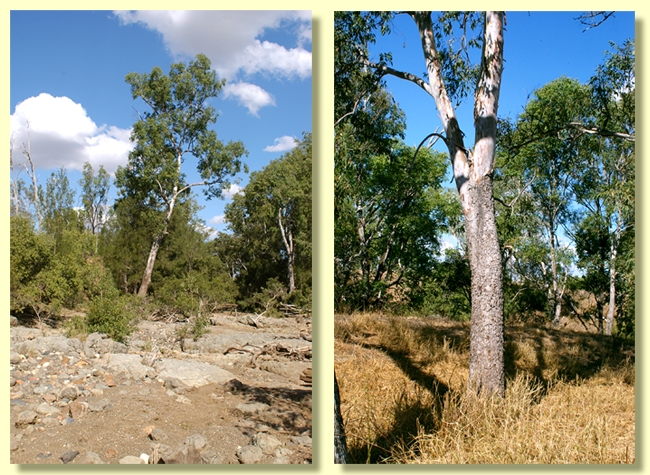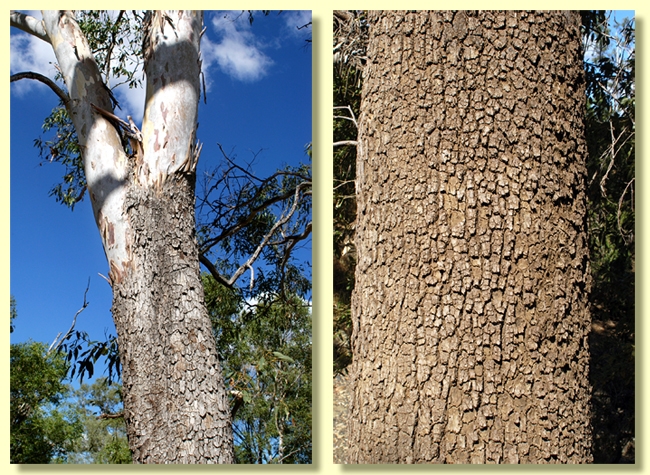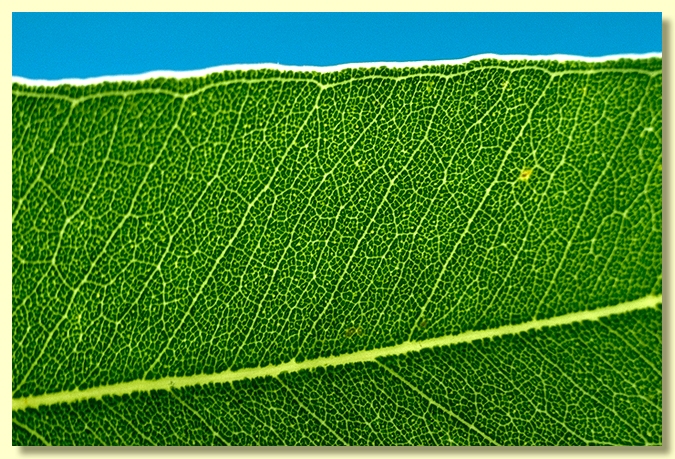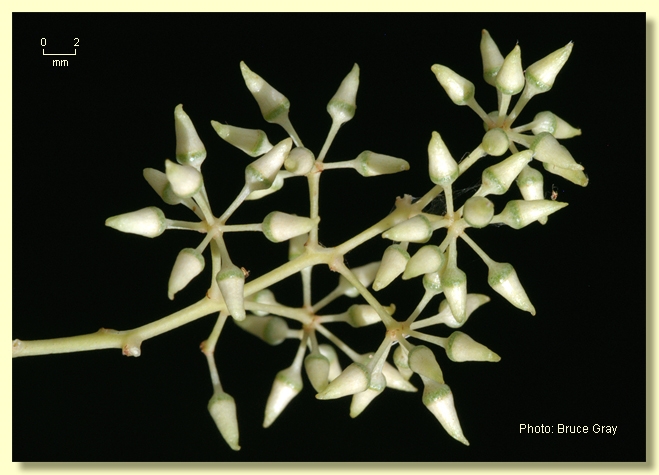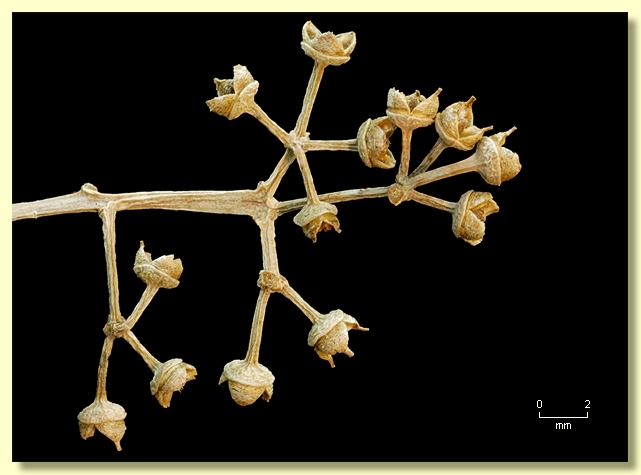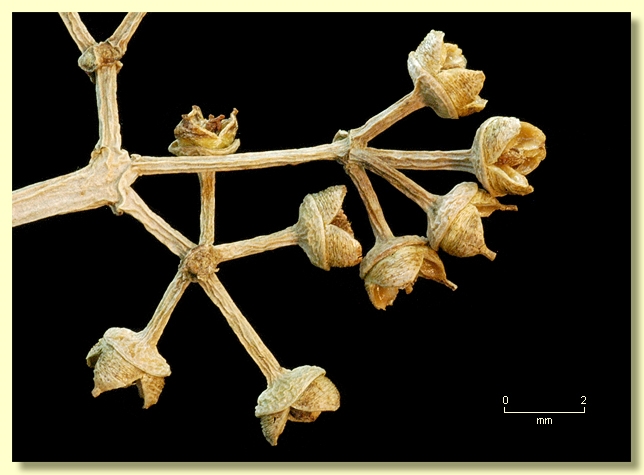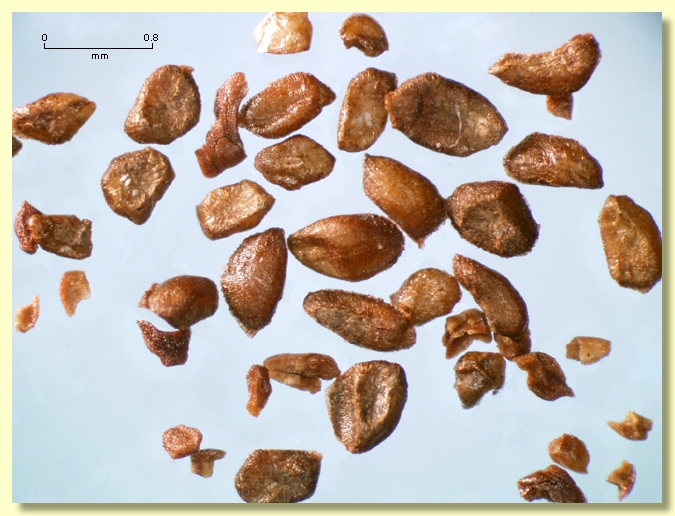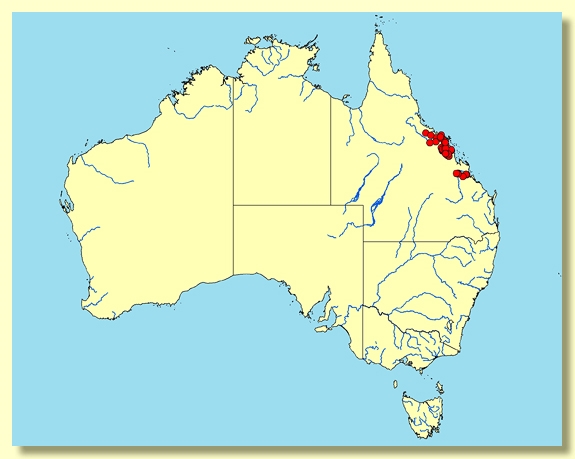Euclid - Online edition
Eucalyptus raveretiana
Eucalyptus | Minutifructus | Domesticae
Eucalyptus raveretiana F.Muell., Fragmenta Phytographiae Australiae 10: 99 (1877).
T: Queensland. Rockhampton, P.A. O'Shanesy 1390, 17 March 1873; lectotype: (MEL1517650); fide :Bean, A.R., Telopea 12(4): 474 (2010).
Tree to 30 m tall. Lignotuber presence/absence unknown, swelling not visible on seedlings.
Bark rough on most or all of trunk and often on bases of large branches sometimes extending to branches 5 cm diameter, box-type, dark grey, thick, becoming fissured and tessellated. Smooth-barked above this, patchy pale grey to pink-grey to grey to green and creamy white shedding in long flakes.
Branchlets lack pith oil glands; glabrous.
Juvenile growth (coppice or field seedlings to 50 cm): stems rounded to square in cross-section, smooth; juvenile leaves always petiolate, alternate, ovate to broadly lanceolate, 5–12.5 cm long, 1.7–5.5 cm wide, base rounded to tapering, apex pointed, margin entire, green, discolorous.
Adult leaves alternate, petioles 0.9–2.6 cm long; blade usually lanceolate, sometimes falcate or ovate, (6.5)8–17.2 cm long, 1–3.5(4.2) cm wide, flat or undulate near margin, base tapering to petiole, margin entire, apex pointed, discolorous, dull, green, side-veins at more than 45° to the midrib, reticulation very dense, intramarginal vein present, oil glands small, intersectional and island.
Inflorescence terminal compound, peduncles 0.1–0.7 cm long, buds 7 per umbel, pedicels 0.1–0.4 cm long. Mature buds ovoid, 0.3–0.4 cm long, 0.15–0.2 cm wide, scar present, operculum acutely conical, stamens irregularly flexed, anthers ± reniform to cuboid, versatile, dorsifixed, dehiscing by longitudinal slits that curve at the top, style long and straight, stigma blunt, locules 3, the placentae each with only ca 8 ovules arranged irregularly or in 2–3 vertical rows. Flowers white.
Fruit pedicellate (pedicels 0.1–0.5 cm long), shallowly hemispherical, 0.05–0.15 cm long, 0.15–0.3 cm wide, the base < 0.1 cm long with exserted valves to 0.15 cm long, disc narrow, level to descending or obscure.
Seeds pale brown, 0.8–1.3 mm long, flattened ovoid, dorsal surface smooth, hilum ventral.
Cultivated seedlings (measured at ca node 10): cotyledons oblong; stems square in cross-section, smooth; leaves always petiolate, opposite for 6 to ca 13 nodes then becoming alternate, ovate to broadly lanceolate, 5–9 cm long, 1.5–3 cm wide, base tapering, apex pointed, green, discolorous
Flowering has been recorded in February and July.
A tree endemic to sub-tropical Queensland found along rivers and creeks from Rockhampton inland to the rivers north of Duaringa, and also inland from Sarina and Mackay north to Bowen and Townsville. Eucalyptus raveretiana prefers silty or loamy soils and grows with Eucalyptus tereticornis and Corymbia tessellaris but also occurs in patches of gallery forest as an emergent. It has the smallest buds and fruit of the eucalypts and is easily distinguished from all eucalypt species with which it grows by the combination of branched inflorescences terminating the branches, buds and fruit less than 3 mm wide, conical operculum, fruit with conspicuously exserted valves, dull, green crown leaves that are paler underneath, rough grey box-type bark on most or all of the trunk and often riverine habitat.
In the classification of Brooker (2000) Eucalyptus raveretiana is placed in Eucalyptus subgenus Minutifructus comprising only four tropical species sharing the characteristics of terminal compound inflorescences, discolorous leaves with dense reticulation and small buds with outer sepals (or operculum) lost very early and an inner petaline operculum that persists until flowering, and tiny fruit. The other three species are E. brachyandra, a species from tropical north-western Australia with small ovate-elliptic leaves, full finely fibrous/stringy bark and sandstone escarpment habitat; E. howittiana, afully rough, box-barked tree with thick-textured lanceolate leaves endemic to north Queensland and found on rocky hillslopes; and the extra-Australian tropical tree species E. deglupta, which has smooth bark and opposite ovate leaves, and forms pure stands on river flats. Eucalyptus deglupta is sporadically distributed from New Britain though Papua New Guinea; West Papua, Celebes, and Ceram in Indonesia; and Mindanao in the Philippines.
Eucalyptus raveretiana is listed as "Vulnerable" under the Australian Government Environment Protection and Biodiversity Conservation Act 1999 (EPBC Act). Further information may be found at this web address:
http://www.environment.gov.au/cgi-bin/sprat/public/sprat.pl
Eucalyptus raveretiana : after C. Raveret-Wattel (ca 1838–1916), a French public servant and vice-president of the Societe D'Acclimisation de France. He was active in introducing eucalypts into cultivation in southern France.

